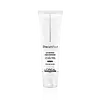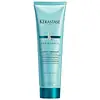L'Oréal Professionnel Steampod Steam-Activated Milk Versus Kérastase Résistance Ciment Thermique Resurfacing Strenghtening Milk
What's inside
What's inside
 Benefits
Benefits

 Concerns
Concerns

 Ingredients Side-by-side
Ingredients Side-by-side

Water
Skin ConditioningCyclopentasiloxane
EmollientPropylene Glycol
HumectantDimethiconol
EmollientTriethanolamine
BufferingPhenoxyethanol
PreservativePEG/PPG-17/18 Dimethicone
EmulsifyingCarbomer
Emulsion StabilisingBehentrimonium Chloride
PreservativeCaprylyl Glycol
EmollientPolyquaternium-4
Potato Starch Modified
Hydroxypropyl Guar
Emulsion StabilisingAmodimethicone
Isopropyl Alcohol
SolventQuaternium-87
CleansingArginine
MaskingGlutamic Acid
HumectantSerine
MaskingHydroxypropyltrimonium Hydrolyzed Wheat Protein
Skin ConditioningTrideceth-6
Emulsifying2-Oleamido-1,3-Octadecanediol
Skin ConditioningAlpha-Isomethyl Ionone
PerfumingCoumarin
PerfumingLinalool
PerfumingCitronellol
PerfumingHexyl Cinnamal
PerfumingBenzyl Alcohol
PerfumingCetrimonium Chloride
AntimicrobialGeraniol
PerfumingParfum
MaskingWater, Cyclopentasiloxane, Propylene Glycol, Dimethiconol, Triethanolamine, Phenoxyethanol, PEG/PPG-17/18 Dimethicone, Carbomer, Behentrimonium Chloride, Caprylyl Glycol, Polyquaternium-4, Potato Starch Modified, Hydroxypropyl Guar, Amodimethicone, Isopropyl Alcohol, Quaternium-87, Arginine, Glutamic Acid, Serine, Hydroxypropyltrimonium Hydrolyzed Wheat Protein, Trideceth-6, 2-Oleamido-1,3-Octadecanediol, Alpha-Isomethyl Ionone, Coumarin, Linalool, Citronellol, Hexyl Cinnamal, Benzyl Alcohol, Cetrimonium Chloride, Geraniol, Parfum
Water
Skin ConditioningCyclopentasiloxane
EmollientPropylene Glycol
HumectantDimethiconol
EmollientTriethanolamine
BufferingPhenoxyethanol
PreservativePEG/PPG-17/18 Dimethicone
EmulsifyingCarbomer
Emulsion StabilisingBehentrimonium Chloride
PreservativePolyquaternium-4
Potato Starch Modified
Hydroxypropyl Guar
Emulsion StabilisingMethylparaben
PreservativeLimonene
PerfumingAmodimethicone
Cetyl Alcohol
EmollientQuaternium-87
CleansingBehentrimonium Methosulfate
Quaternium-33
Trideceth-6
Emulsifying2-Oleamido-1,3-Octadecanediol
Skin ConditioningGeraniol
PerfumingLinalool
PerfumingGlycerin
HumectantCitronellol
PerfumingCitral
PerfumingCetrimonium Chloride
AntimicrobialTrehalose
HumectantTamarindus Indica Seed Polysaccharide
Skin ConditioningMyrothamnus Flabellifolia Leaf Extract
EmollientParfum
MaskingWater, Cyclopentasiloxane, Propylene Glycol, Dimethiconol, Triethanolamine, Phenoxyethanol, PEG/PPG-17/18 Dimethicone, Carbomer, Behentrimonium Chloride, Polyquaternium-4, Potato Starch Modified, Hydroxypropyl Guar, Methylparaben, Limonene, Amodimethicone, Cetyl Alcohol, Quaternium-87, Behentrimonium Methosulfate, Quaternium-33, Trideceth-6, 2-Oleamido-1,3-Octadecanediol, Geraniol, Linalool, Glycerin, Citronellol, Citral, Cetrimonium Chloride, Trehalose, Tamarindus Indica Seed Polysaccharide, Myrothamnus Flabellifolia Leaf Extract, Parfum
Ingredients Explained
These ingredients are found in both products.
Ingredients higher up in an ingredient list are typically present in a larger amount.
We don't have a description for 2-Oleamido-1,3-Octadecanediol yet.
This water-soluble silicone is used for its hydrating and softening properties. It is used to add a silky feel to skincare products and has great benefits for haircare.
In haircare, this ingredient:
- Adds shine
- Protects color
- Offers thermal protection
- Boosts hair strength
- Does not build up as easily
This ingredient is a preservative and often used for it's anti-static properties. You'll most likely see this ingredient in hair conditioners.
It does not cause irritation or sensitization in leave-on products at 1-5%.
Carbomer is a polymer of acrylic acid. Its main role is to create a gel consistency.
A high amount of carbomer can cause pilling or balling up of products. Don't worry, most products contain 1% or less of carbomer.
This ingredient is a preservative, antimicrobial, and emulsifier. It is often used in cosmetics for its ability to cleanse, condition, and reduce static.
Cetrimonium chloride is a quaternary ammonium salt, meaning it has a water-soluble structure.
Citronellol is used to add fragrance/parfum to a product. It is often derived from plants such as roses. In fact, it can be found in many essential oils including geranium, lavender, neroli, and more. The scent of Citronellol is often described as "fresh, grassy, and citrus-like".
Since the Citronellol molecule is already unstable, Citronellol becomes irritating on the skin when exposed to air.
Citronellol is a modified terpene. Terpenes are unsaturated hydrocarbons found in plants. They make up the primary part of essential oils.
Citronellol is not able to be absorbed into deeper layers of the skin. It has low permeability,
Citronellol is also a natural insect repellent.
Learn more about CitronellolCyclopentasiloxane, or D5, is a silicone used to improve texture of products and trap moisture.
D5 is considered lightweight and volatile. Volatile means it evaporates quickly after application. Once evaporated, D5 leaves a thin barrier that helps keep skin hydrated.
It is also an emollient. Emollients help soften the skin and prevent water loss. Silicones create a silky texture in products. D5 helps other ingredients become more spreadable.
Studies show D5 is safe to use in skincare products. We recommend speaking with a skincare professional if you have concerns.
Learn more about CyclopentasiloxaneDimethiconol is a silicone that resembles the popular dimethicone. Like other silicones, it is an emollient. Emollients create a thin film on skin to prevent moisture from escaping.
This ingredient helps to create a silky texture and improve spreadability. Due to its high molecular weight and thickness, it is often combined with cyclopentasiloxane.
Geraniol is used to add fragrance/parfum to a product. It is the main component of citronellol. It is a monoterpenoid and an alcohol.
Monoterpenes are naturally found in many parts of different plants.
Geraniol can be found in many essential oils including Rose Oil and Citronella Oil. The scent of Geraniol is often described as "rose-like". Many foods also contain Geraniol for fruit flavoring.
Geraniol can irritate the skin when exposed to air. However, irritation depends on the ability of geraniol to penetrate into the skin. In general, geraniol is not able to penetrate skin easily.
Geraniol is colorless and has low water-solubility. However, it is soluble in common organic solvents.
Like citronellol, it is a natural insect repellent.
2,6-Octadien-1-ol, 3,7-dimethyl-, (2E)-
Learn more about GeraniolWe don't have a description for Hydroxypropyl Guar yet.
Linalool is a fragrance and helps add scent to products. It's derived from common plants such as cinnamon, mint, citrus, and lavender.
Like Limonene, this ingredient oxidizes when exposed to air. Oxidized linalool can cause allergies and skin sensitivity.
This ingredient has a scent that is floral, spicy tropical, and citrus-like.
Learn more about LinaloolParfum is a catch-all term for an ingredient or more that is used to give a scent to products.
Also called "fragrance", this ingredient can be a blend of hundreds of chemicals or plant oils. This means every product with "fragrance" or "parfum" in the ingredients list is a different mixture.
For instance, Habanolide is a proprietary trade name for a specific aroma chemical. When used as a fragrance ingredient in cosmetics, most aroma chemicals fall under the broad labeling category of “FRAGRANCE” or “PARFUM” according to EU and US regulations.
The term 'parfum' or 'fragrance' is not regulated in many countries. In many cases, it is up to the brand to define this term.
For instance, many brands choose to label themselves as "fragrance-free" because they are not using synthetic fragrances. However, their products may still contain ingredients such as essential oils that are considered a fragrance by INCI standards.
One example is Calendula flower extract. Calendula is an essential oil that still imparts a scent or 'fragrance'.
Depending on the blend, the ingredients in the mixture can cause allergies and sensitivities on the skin. Some ingredients that are known EU allergens include linalool and citronellol.
Parfum can also be used to mask or cover an unpleasant scent.
The bottom line is: not all fragrances/parfum/ingredients are created equally. If you are worried about fragrances, we recommend taking a closer look at an ingredient. And of course, we always recommend speaking with a professional.
Learn more about ParfumPEG/PPG-17/18 Dimethicone is a type of silicone.
Phenoxyethanol is a preservative that has germicide, antimicrobial, and aromatic properties. Studies show that phenoxyethanol can prevent microbial growth. By itself, it has a scent that is similar to that of a rose.
It's often used in formulations along with Caprylyl Glycol to preserve the shelf life of products.
We don't have a description for Polyquaternium-4 yet.
We don't have a description for Potato Starch Modified yet.
Propylene Glycol is an odorless, colorless liquid. As a humectant, it helps skin retain moisture. It also aids in delivering active ingredients.
Another role of this ingredient is preventing a product from melting or freezing. Propylene glycol also adds antimicrobrial properties to a product, elongating product lifespan.
This ingredient is considered an organic alcohol and commonly added into both cosmetics and foods.
Those with sensitive skin or conditions may develop a rash when using this ingredient.
Learn more about Propylene GlycolWe don't have a description for Quaternium-87 yet.
We don't have a description for Trideceth-6 yet.
Triethanolamine is an emulsifier and pH adjuster. It is created using ethylene oxide and ammonia. This gives Triethanolamine a nitrogen core and a similar scent to ammonia.
As an emulsifier, it prevents ingredients from separating and enhances texture by adding volume to a product.
PH adjusters are common in cosmetic products. The pH of a product can affect the effectiveness of other ingredients. A product with a high pH may also irritate the skin.
Learn more about TriethanolamineWater. It's the most common cosmetic ingredient of all. You'll usually see it at the top of ingredient lists, meaning that it makes up the largest part of the product.
So why is it so popular? Water most often acts as a solvent - this means that it helps dissolve other ingredients into the formulation.
You'll also recognize water as that liquid we all need to stay alive. If you see this, drink a glass of water. Stay hydrated!
Learn more about Water